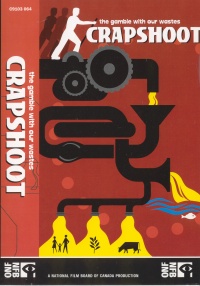| ________________
CM . . .
. Volume XI Number 8 . . . . December 10, 2004
The wyrd sisters in Macbeth were able to predict the future using a brew made of disgusting ingredients. While repulsive, their mixture is nothing in comparison to the toxic stew that is being created each day all over the world by sewer systems. The future predicted by this concoction is grim indeed. Crapshoot is a hard-hitting attack on the globally accepted method of using water to move waste of all kinds away from the area of use. The sewer made its debut in the height of ancient Rome. The largest operating sewer in the world was unveiled there in 616 B.C. The ancient Roman principle of using water to move their waste from where they were, downstream to where they were not, is still being practiced today--at our peril apparently. When the Roman Empire fell, so too did waste management, and, until the Industrial Revolution, human waste found itself everywhere. Plagues were common, and sanitation was a concept forgotten. When the sewer technology was re-utilized, raw sewage found itself flushed into various rivers and oceans. This technology when brought to India by the British in 1917, sent tonnes of human waste into the Ganges River. It is now 340,000 times beyond a pollution level which is considered safe. Following thousands of years of tradition, devout Hindus are required to bathe in its waters. The film understands that this practice is essential to their faith, but is concerned about the people's safety. Lest the Western world should feel superior, the locale changes to St. John's, Newfoundland. Here, the natural bowl shape of the harbour has captured the raw sewage that enters the water each day. At the bottom lies "fifteen feet of crap." This is not unique to St. John's. Eighty per cent of coastal communities dump raw sewage into the ocean. Added to this are the many chemicals that are used in our daily lives. Water treatment plants cannot filter out all the toxins or contaminants. The impact on wildlife is becoming clear. Humans cannot be immune, but no one seems to see the danger. Crapshoot shows that bad past thinking has determined how waste will be managed today. Before a new subdivision is erected, the sewer system is established. That area will continue what has become the standard in sanitation. If the sewers carried only human waste, perhaps there could be a solution. However, the mixing of chemicals and wastes in the sewers is a dangerous thing. One of the by-products of water treatment facilities is sewer sludge--a mixture of chemicals, heavy metals, pharmaceuticals, petrochemicals-everything that finds its way down a drain. How to deal with this sludge is yet another problem. Some communities allow the spreading of this sludge onto farmers' fields. In some areas, this practice is actually encouraged by the government. However, the pathogens and chemical pollutants do not disappear. At times, the need to get rid of the sludge takes precedence over human safety. Sweden once spread sewer sludge on its fields as a matter of practice. However, with the increase of cancers and the appearance of toxins in mothers' breast milk, the public forced a ban on the practice of spreading sewage sludge on farmers' fields. Other technologies are presented in the film. Edmonton, for example, utilizes a cold compost process which combines garbage and sludge. This results in a fertilizer which is packaged and sold to the public. The film does not celebrate this practice. Bear River, Nova Scotia, on the other hand, has placed their water treatment plant in the centre of town. As a result, the people are reminded daily that they contribute to the waste water stream. They seem more aware of what is sent down a drain and seem to be acting more prudently. Crapshoot offers a number of alternative methods to waste water management, and, while the ideology is probably wise, there is no cost presented. The haunting message of the film is that nothing flushed down the toilet is ever just gone. The problem caused by using water to move our waste cannot be solved by technology. This will take a major social change. Crapshoot is a disturbing film, and it means to be. Contemporary society is creating its own witches brew, and the future it predicts will be our undoing. While it may appear one-sided, Crapshoot could generate a healthy discussion. The film would have great applicability in courses with environmental units, but it could also be used in Sociology, Law, Civics, Science, Ethics or Technology. Highly Recommended. Frank Loreto is a teacher-librarian at St. Thomas Aquinas Secondary School in Brampton, ON.
To comment
on this title or this review, send mail to cm@umanitoba.ca.
Copyright © the Manitoba Library Association. Reproduction for personal
use is permitted only if this copyright notice is maintained. Any
other reproduction is prohibited without permission.
NEXT REVIEW |TABLE OF CONTENTS FOR THIS ISSUE
- December 10, 2004.
AUTHORS
| TITLES | MEDIA REVIEWS
| PROFILES
| BACK ISSUES
| SEARCH | CMARCHIVE
| HOME |
